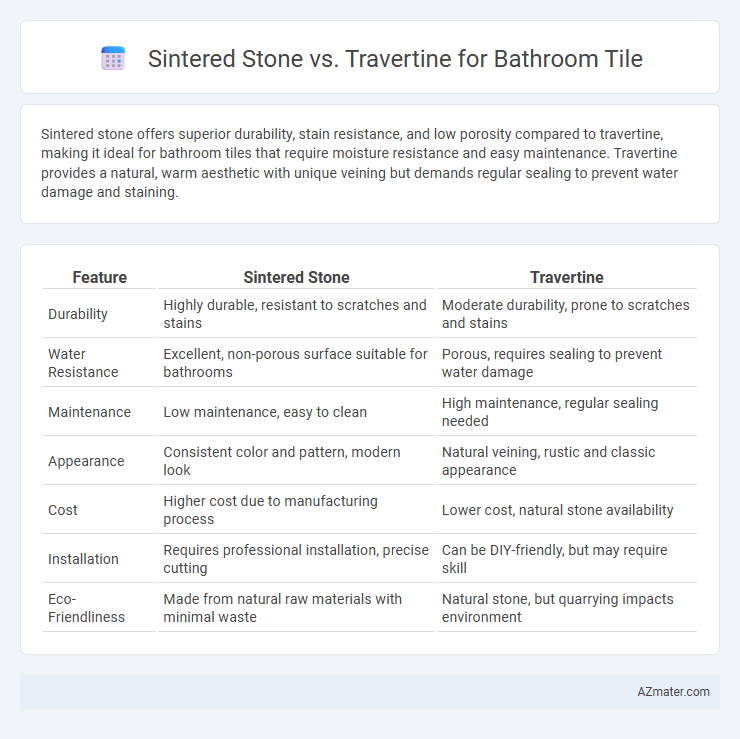Sintered stone offers superior durability, stain resistance, and low porosity compared to travertine, making it ideal for bathroom tiles that require moisture resistance and easy maintenance. Travertine provides a natural, warm aesthetic with unique veining but demands regular sealing to prevent water damage and staining.
Table of Comparison
| Feature | Sintered Stone | Travertine |
|---|---|---|
| Durability | Highly durable, resistant to scratches and stains | Moderate durability, prone to scratches and stains |
| Water Resistance | Excellent, non-porous surface suitable for bathrooms | Porous, requires sealing to prevent water damage |
| Maintenance | Low maintenance, easy to clean | High maintenance, regular sealing needed |
| Appearance | Consistent color and pattern, modern look | Natural veining, rustic and classic appearance |
| Cost | Higher cost due to manufacturing process | Lower cost, natural stone availability |
| Installation | Requires professional installation, precise cutting | Can be DIY-friendly, but may require skill |
| Eco-Friendliness | Made from natural raw materials with minimal waste | Natural stone, but quarrying impacts environment |
Introduction to Sintered Stone and Travertine
Sintered stone is an engineered material made from natural minerals compressed and heated at high temperatures, offering exceptional durability, stain resistance, and low porosity ideal for bathroom tile applications. Travertine, a natural sedimentary limestone characterized by its porous texture and warm, earthy tones, requires sealing to prevent water absorption and staining in wet environments like bathrooms. Both materials provide unique aesthetic and functional qualities, but sintered stone's enhanced strength and maintenance advantages make it a popular modern choice for bathroom surfaces.
Visual Appeal: Sintered Stone vs Travertine
Sintered stone offers a modern, sleek visual appeal with consistent color patterns and a wide range of finishes that mimic natural materials while providing enhanced durability. Travertine features a classic, warm aesthetic with unique porous textures and natural veining that add character and elegance to bathroom spaces. The choice between sintered stone and travertine depends on whether you prefer uniform sophistication or organic, rustic charm in bathroom tile design.
Durability and Strength Comparison
Sintered stone exhibits superior durability and strength compared to travertine, making it highly resistant to scratches, stains, and heavy impacts ideal for bathroom tile applications. Travertine, a natural limestone, is softer and more porous, requiring regular sealing to prevent damage from moisture and wear. The compact composition of sintered stone enhances its structural integrity, ensuring long-lasting performance in high-traffic, wet environments.
Water and Stain Resistance Properties
Sintered stone offers superior water and stain resistance compared to travertine, making it an ideal choice for bathroom tiles exposed to moisture and frequent spills. Its non-porous surface prevents water absorption and resists staining from cosmetics, soap, and hard water deposits, which commonly affect travertine's porous calcium carbonate structure. While travertine requires regular sealing to maintain its appearance and durability, sintered stone remains low-maintenance and highly resilient in humid environments.
Maintenance and Cleaning Requirements
Sintered stone offers superior resistance to stains, scratches, and moisture compared to travertine, making it easier to maintain in bathroom environments. Travertine requires regular sealing to prevent water absorption and staining, while sintered stone's non-porous surface minimizes the need for sealing and intensive cleaning. Cleaning sintered stone typically involves mild detergents and water, whereas travertine demands pH-neutral cleaners to avoid surface etching and damage.
Eco-Friendliness and Sustainability
Sintered stone offers superior eco-friendliness compared to travertine, as it is manufactured using natural minerals and recycled materials with minimal water and energy consumption. Travertine, a natural limestone, requires extensive quarrying that impacts landscapes and produces more waste, making it less sustainable. The durability and low porosity of sintered stone also extend the lifespan of bathroom tiles, reducing the need for frequent replacement and minimizing environmental impact.
Slip Resistance and Safety in Bathrooms
Sintered stone offers superior slip resistance compared to travertine, making it a safer option for bathroom floors where moisture increases the risk of slipping. Its non-porous surface minimizes water absorption, reducing the likelihood of slipping hazards caused by wet tiles. Travertine, while aesthetically pleasing, tends to be more porous and can become slippery when wet, requiring additional treatments or rugs to enhance bathroom safety.
Installation Process: Complexity and Time
Sintered stone requires precise cutting tools and professional installation due to its hardness and density, resulting in longer installation times compared to travertine. Travertine tiles are softer and easier to cut, allowing for quicker and less complex installation, but they need sealing to prevent water absorption. While sintered stone offers durability and minimal maintenance post-installation, its complexity demands experienced installers to ensure proper fitting and alignment in bathroom settings.
Cost Differences: Sintered Stone vs Travertine
Sintered stone typically costs between $50 and $100 per square foot, offering a durable, low-maintenance option ideal for bathroom tiles, while travertine ranges from $5 to $30 per square foot but requires more upkeep due to its porous nature. The higher initial investment in sintered stone is offset by its resistance to stains, scratches, and moisture, making it a cost-effective choice over time. Travertine's lower upfront cost suits budget-conscious projects but may incur additional expenses for sealing and maintenance to prevent damage in wet bathroom environments.
Best Applications and Design Tips for Each Material
Sintered stone excels in bathroom tile applications due to its exceptional durability, resistance to stains, and low porosity, making it ideal for high-moisture areas like shower walls and floors. Travertine offers a natural, warm aesthetic with unique veining patterns, best suited for accent walls or vanity tops where slip resistance is less critical. For design, pair sintered stone with contemporary fixtures to highlight its sleek, uniform surface, while travertine complements rustic or Mediterranean styles with its textured, porous finish requiring regular sealing.

Infographic: Sintered stone vs Travertine for Bathroom Tile
 azmater.com
azmater.com